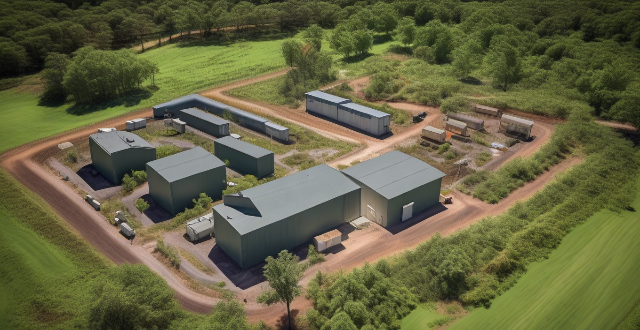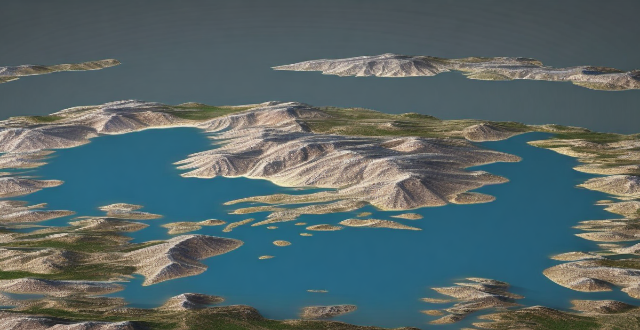Climate Temperature

How does temperature control affect food safety ?
This text discusses the impact of temperature control on food safety, emphasizing the risks associated with improper temperature management and the benefits of maintaining appropriate temperatures. It highlights the danger zone for bacterial growth, spoilage due to mold and yeast, and toxin production from bacteria. The article also outlines best practices for temperature control in refrigeration, freezing, cooking, reheating, handling, and storage to ensure food safety.

Why is temperature control important in food storage and preparation ?
Temperature control is crucial in food storage and preparation to ensure safety, quality, and longevity of food products. It prevents bacterial growth, avoids toxin production, maintains flavor and texture, preserves nutrients, extends shelf life, reduces waste, saves energy, and reduces environmental impact. Proper temperature control helps to enjoy delicious and healthy meals while minimizing the risk of foodborne illnesses and food waste.

How does climate change impact the nutritional value of crops ?
Climate change is affecting the nutritional value of crops by altering CO2 levels, temperature fluctuations, and water availability. Elevated CO2 concentrations can lead to nutrient dilution in staple crops like wheat, rice, and soybeans. Temperature extremes cause protein denaturation and interfere with enzyme function, reducing nutrient content. Water stress from drought or flooding impairs nutrient uptake and synthesis. Adaptation strategies include breeding resilient crop varieties, implementing efficient irrigation systems, and using protective structures against extreme temperatures. By addressing these challenges, it's possible to maintain crop nutrition amidst climate change impacts.

What is the ideal room temperature for optimal sleep ?
The ideal room temperature for optimal sleep is between 60-67°F (15-19°C). This range is considered to be the most conducive for a comfortable and restful sleep. The reasons for this include regulation of body temperature, improved REM sleep, reduced wakefulness, and comfort and relaxation. To achieve the ideal room temperature, consider using an air conditioner or fan, adjusting your bedding, dressing appropriately, and using a programmable thermostat.

How does climate change impact human rights ?
The impact of climate change on human rights is multifaceted and far-reaching. It affects health and well-being, food security, water access, displacement and migration, and indigenous rights. Extreme weather events can cause physical harm and death, while rising temperatures can lead to an increase in infectious diseases. Changes in temperature and precipitation patterns can disrupt agricultural production, leading to crop failures and food shortages. Water scarcity can occur as glaciers and snowpacks melt faster than they can be replenished. Displacement and migration can have serious consequences for safety, security, and rights. Indigenous communities are often particularly vulnerable to the impacts of climate change because they rely heavily on natural resources for their livelihoods and cultural practices.

How do different regions of the world experience climate variability differently ?
The article discusses climate variability and how different regions of the world experience it. Tropical regions have high temperatures and rainfall but also extreme weather events like hurricanes and monsoons, influenced by El Niño Southern Oscillation (ENSO). Arid and semi-arid regions face very little precipitation and high temperatures, making them vulnerable to climate change impacts. Polar regions experience extreme cold temperatures and limited sunlight in winter, with rapid warming due to climate change leading to melting ice caps and rising sea levels. Temperate regions have moderate temperatures and seasonal precipitation variations, with four distinct seasons and varying weather patterns, but can still be affected by extreme weather events like floods, droughts, and heatwaves.

What are the ethical implications of climate change on human rights ?
Climate change affects the fundamental rights of individuals and communities worldwide through its impacts on health, food security, water access, and displacement. Rising temperatures and extreme weather events can lead to an increase in heat-related illnesses, respiratory problems, and infectious diseases, as well as exacerbate existing health disparities. Changes in temperature and precipitation patterns can disrupt agricultural production, leading to crop failures and reduced yields, resulting in food shortages, increased prices, and malnutrition. Climate change poses significant threats to water availability and quality, with rising temperatures leading to increased evaporation rates, droughts, and water scarcity. Displacement due to rising sea levels, flooding, and other environmental factors can result in loss of homes, livelihoods, and social networks, as well as increased vulnerability to violence and exploitation. It is imperative that governments, international organizations, and individuals take urgent action to mitigate the effects of climate change and protect the fundamental rights of all people, prioritizing the needs of vulnerable populations.

What are the long-term implications of neglecting climate adaptation efforts ?
Neglecting climate adaptation efforts can have far-reaching and long-lasting implications for our planet, its ecosystems, and human societies. These implications are multifaceted and interconnected, affecting various aspects of life on Earth. Below, we will explore some of the key long-term implications in detail: ### **Environmental Consequences** #### *Loss of Biodiversity* - **Habitat Destruction**: Rising temperatures and changing weather patterns can disrupt habitats, leading to a decline in biodiversity. - **Species Extinction**: Some species may not be able to adapt quickly enough to the changing conditions, resulting in extinction. #### *Ocean Acidification* - **Marine Ecosystems**: Increased carbon dioxide levels in the atmosphere lead to ocean acidification, which harms marine life, especially shellfish and coral reefs. ### **Economic Impacts** #### *Agriculture and Food Security* - **Reduced Crop Yields**: Changes in temperature and precipitation patterns can negatively affect crop yields, leading to food scarcity and price hikes. - **Livestock Production**: Heat stress and changes in feed quality can impact livestock production, further exacerbating food security issues. #### *Infrastructure Damage* - **Coastal Erosion**: Rising sea levels can cause coastal erosion, damaging infrastructure such as roads, buildings, and energy facilities. - **Extreme Weather Events**: More frequent and severe weather events like hurricanes, floods, and droughts can cause significant damage to infrastructure and lead to costly repairs. ### **Social and Health Impacts** #### *Displacement and Migration* - **Climate Refugees**: As living conditions deteriorate due to climate change, people may be forced to leave their homes, leading to mass migration and potential conflicts over resources. - **Urbanization**: People may move to cities seeking better living conditions, which could strain urban infrastructure and services. #### *Health Risks* - **Heat-related Illnesses**: Higher temperatures can lead to heat stroke, dehydration, and other heat-related illnesses. - **Spread of Diseases**: Warmer temperatures can expand the range of disease-carrying organisms like mosquitoes and ticks, increasing the risk of diseases like malaria, dengue fever, and Lyme disease. ### **Summary** Neglecting climate adaptation efforts has far-reaching consequences that extend beyond environmental degradation to include economic instability, social unrest, and public health risks. It is crucial for governments, businesses, and individuals to take proactive steps towards climate adaptation to mitigate these long-term implications and ensure a sustainable future for all.

How do different climates affect the choice and efficiency of energy storage systems ?
Climate plays a crucial role in determining the type, choice, and efficiency of energy storage systems. Variations in temperature, humidity, and other environmental factors can significantly impact the performance and longevity of these solutions. For instance, high temperatures can cause battery degradation and reduce their lifespan, while low temperatures can decrease the battery's capacity and output power. High humidity can cause corrosion and damage to the battery's components, reducing its lifespan and efficiency. Similarly, climate change can affect the availability of water for pumped hydro storage systems, and higher temperatures can increase evaporation rates, reducing the amount of water available for energy storage. Therefore, it is essential to consider the local climate conditions when selecting and designing energy storage systems to maximize their performance and longevity.

How does the climate emergency affect biodiversity and ecosystems ?
The climate emergency is causing significant changes in global temperatures, weather patterns, and precipitation, which have profound impacts on biodiversity and ecosystems. These effects include habitat loss and alteration due to rising sea levels, changing precipitation patterns, and temperature fluctuations. Species are being displaced or facing extinction as they struggle to adapt to new conditions, leading to disrupted food webs. The decline in ecosystem services such as water regulation, nutrient cycling, and disease regulation further exacerbates the situation. Resilience and adaptation challenges highlight the need for immediate action to mitigate damage and promote ecological resilience through conservation and sustainable practices.

Hwinfo, a hardware monitoring tool, released version 6.42: improve accuracy and support RTX 30 series partial video memory temperature monitoring

What is global warming and how does it affect the Earth's climate ?
Global warming is causing rising sea levels, extreme weatherGlobal warming is causing rising sea levels, extreme weatherdiversity, ocean acid ocean acidification, melting permafrost, changes in precipitation patterns, and agricultural impacts. It is a complex issue with far-reaching consequences for our planet's climate. Addressing global warming requires international cooperation and concerted efforts to reduce GHG emissions and transition to renewable energy sources.

Can climate data analysis provide solutions to climate change problems ?
Climate data analysis is crucial for understanding climate change, predicting future scenarios, and developing solutions to mitigate its impact. It helps identify trends in temperature, precipitation, and other variables, predict changes in sea levels, extreme weather events, and ecosystem shifts. Solutions derived from this analysis include transitioning to renewable energy, improving energy efficiency, promoting sustainable forestry and agriculture, and international cooperation on climate action.

What is climate vulnerability ?
Climate vulnerability refers to the susceptibility of a system or population to harm from climate-related stresses and extremes. Key factors contributing to this include exposure, sensitivity, and adaptive capacity. Examples of vulnerable systems include low-lying islands, agricultural communities, coastal cities, ecosystems, and human health. Addressing climate vulnerability involves assessing risks, implementing adaptation measures, building resilience, mitigating emissions, and encouraging sustainable practices.

How do scientists study climate change ?
Scientists study climate change through observational data, modeling, and field research. They use satellites, weather stations, ocean floats, climate models, paleoclimate reconstructions, ice cores, coral reefs, tree rings, and interdisciplinary collaboration to collect and analyze data. They also publish synthesis reports like the IPCC Assessment Reports to summarize current scientific knowledge on climate change.

How does climate variability affect global weather patterns ?
The impact of climate variability on global weather patterns is substantial, affecting temperature, precipitation, wind patterns, and extreme weather events. Key influences include El Niño and La Niña phases, monsoon systems, altered rainfall distribution, jet stream variations, tropical cyclones, heatwaves, cold spells, storms, floods, and droughts. Long-term climate trends like global warming also significantly affect weather patterns. Understanding these interactions is crucial for predicting future conditions and addressing climate-related challenges.

What role does the El Niño Southern Oscillation (ENSO) play in climate variability ?
The El Niño Southern Oscillation (ENSO) is a significant ocean-atmosphere phenomenon that influences global climate variability on inter-annual timescales. Its effects include changes in precipitation patterns, temperature fluctuations, and increased frequency of extreme weather events like hurricanes, floods, and droughts. ENSO's impact varies regionally, affecting areas such as North and South America, Australia, Africa, Asia, and Oceania differently. Understanding ENSO is essential for seasonal climate forecasting and plays a vital role in climate models used to predict future climate change scenarios.

How do different regions of the world experience the impacts of climate change on agriculture differently ?
Climate change affects agriculture differently across the globe, depending on local climate conditions, soil types, water availability, and agricultural practices. In tropical regions, high temperatures and humidity, along with frequent extreme weather events and pest and disease pressure, negatively impact crop yields. Arid and semi-arid regions face water scarcity due to reduced rainfall and increased evaporation rates, leading to limited agricultural productivity. Desertification causes soil degradation and loss of arable land. Temperate regions experience changes in precipitation patterns, affecting crop growth, while warmer winters can extend growing seasons. Extreme weather events can damage crops and reduce yields. Polar regions see extended growing seasons due to warming temperatures, but permafrost melting causes soil instability, and changes in ocean currents affect fishing industries. Mountainous regions face changes in temperature and precipitation that alter snowmelt timing and amount, affecting water availability for irrigation. Glacier retreat reduces water supplies for downstream communities and agriculture, while natural disasters like landslides destroy crops and damage infrastructure.

How do different ecosystems respond to changes in temperature and precipitation patterns ?
This article discusses the impacts of changes in temperature and precipitation patterns on different ecosystems, including forests, grasslands, wetlands, and arctic tundra. It highlights how these changes can affect plant growth and productivity, species composition, water availability, nutrient cycling, soil erosion, and other ecosystem processes. The article also emphasizes the importance of understanding these impacts to inform conservation and management strategies for ecosystems in a changing climate.

What is a climate refugee ?
Climate refugees are individuals who must relocate due to environmental changes from climate change, such as sea-level rise and extreme weather events. This displacement affects social structures, economies, and cultures, and there is a need for international cooperation and sustainable practices to address the issue. There is currently no specific legal status for climate refugees under international law.

What is the role of global warming in climate disasters ?
The article discusses the significant role of global warming in climate disasters, highlighting its impacts on extreme weather events, sea level rise, ecosystems, and food security. It emphasizes the importance of taking action to mitigate these effects through strategies such as reducing greenhouse gas emissions, adapting to changing climate conditions, supporting research and innovation, and encouraging international cooperation.

How do climate-related risks such as sea level rise and temperature increase affect energy production and distribution ?
Climate change poses significant risks to the energy sector, affecting both production and distribution. These risks include reduced power plant efficiency due to higher temperatures, changes in energy demand patterns, disruptions to infrastructure from sea level rise and extreme weather events, shifts in preferred energy sources, the need for adaptation and resilience efforts, and potential regulatory and policy changes aimed at reducing emissions and promoting renewables. Addressing these challenges requires a comprehensive strategy that encompasses both adaptation and mitigation measures to ensure a sustainable and resilient energy future.

What is climate variability and how does it differ from climate change ?
Climate variability refers to the natural fluctuations in weather patterns over time, including changes in temperature and precipitation. Examples include seasonal variations, El Niño Southern Oscillation (ENSO), and North Atlantic Oscillation (NAO). Climate change, on the other hand, is a long-term shift in global climate conditions often caused by human activities, leading to increased greenhouse gas concentrations in the atmosphere. Key differences between the two are their timescales, causes, trends vs fluctuations, and impacts. Understanding both concepts is crucial for preparing for future environmental challenges.

How can we differentiate between legitimate climate science and the opinions of climate skeptics ?
This article provides guidance on how to differentiate between legitimate climate science and the opinions of climate skeptics. It emphasizes the importance of looking for peer-reviewed research, checking the source of information, evaluating the evidence, considering the motives of those making claims, and consulting experts in the field. By following these guidelines, individuals can make informed decisions about climate change and contribute to efforts to address this critical issue.

What is a climate model and how does it work ?
A climate model is a computational representation of the interactions between various components of the climate system, used by scientists to simulate and understand the behavior of the Earth's climate. It involves data collection, mathematical equations, numerical methods, computational simulation, and model evaluation and validation. There are several types of climate models, including atmospheric models, ocean models, coupled models, ice sheet models, and ecosystem models.

How do climate summits contribute to global efforts to combat climate change ?
Climate summits play a crucial role in the global fight against climate change by setting targets and goals, encouraging international cooperation, promoting policy and technological innovation, raising awareness and mobilizing action, and financing climate action.